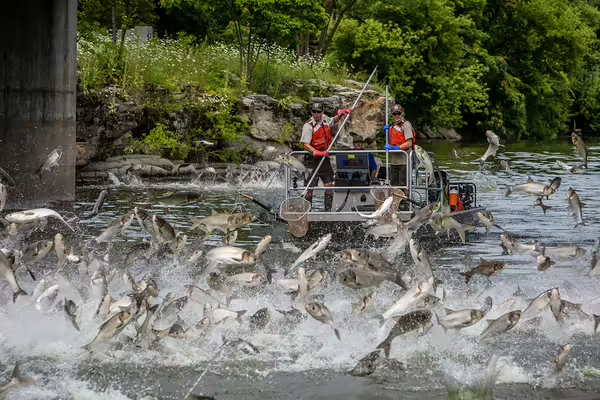
URBANA, Ill. — Invasive silver carp have been spreading throughout the Mississippi River Basin since their introduction a half-century ago. Yet, try as they might, the fish have not advanced beyond a particular stretch of the Illinois River north of Kankakee. Research from the University of Illinois Urbana-Champaign shows the fish are likely avoiding contaminants from the Chicago Area Waterway, which flows south before petering out around Kankakee.
A new study, published today in Scientific Reports, shows silver carp change their behavior and metabolism when introduced to water from the Illinois River north of Kankakee, representing Chicago-area water.
“When animals experience a stressor, sometimes they'll just get out of there. They think, ‘This is terrible, I'm leaving,’ and they scoot. But sometimes they reduce activity and hunker down. These animals think, ‘I'm just going to ride this out and see if conditions improve.’ When we put the carp in the Chicago water, that's what they did –- they reduced activity and stopped moving,” said study co-author Cory Suski, professor in the Department of Natural Resources and Environmental Sciences (NRES) in the College of Agricultural, Consumer and Environmental Sciences (ACES) at Illinois.
Suski and his colleagues from the University of Texas and the U.S. Geological Survey (USGS) trucked water from north of the Kankakee area to a USGS fish hatchery, where they compared silver carp behavior in water from the Chicago Area Waterway and from the laboratory.
Read the full release from the College of ACES.
University of Illinois Extension develops educational programs, extends knowledge, and builds partnerships to support people, communities, and their environments as part of the state's land-grant institution. Extension serves as the leading public outreach effort for University of Illinois Urbana-Champaign and the College of Agricultural, Consumer and Environmental Sciences in all 102 Illinois counties through a network of 27 multi-county units and over 700 staff statewide. Extension’s mission is responsive to eight strategic priorities — community, economy, environment, food and agriculture, health, partnerships, technology and discovery, and workforce excellence — that are served through six program areas — 4-H youth development, agriculture and agribusiness, community and economic development, family and consumer science, integrated health disparities, and natural resources, environment, and energy.